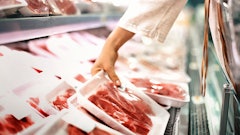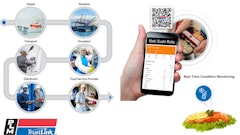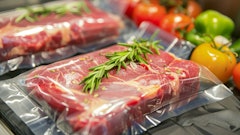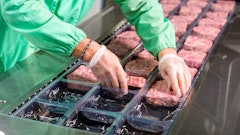
Foodborne illness continues to pose a significant threat to our public health. According to Center for Disease Control (CDC) data, there are nearly 48 million U.S. cases of foodborne illness annually, equating to one in six Americans getting sick each year. The country is currently amidst its most dangerous foodborne illness outbreak since 2011. The CDC announced that nine people have now died from a recent Listeria outbreak linked to Boar’s Head deli meat, with a total of 57 hospitalizations across 18 states. Those numbers are expected to rise over the next several weeks considering it takes 3-4 weeks to determine if sicknesses are due to an outbreak.
The situation underscores a stark reality today that deserves far greater attention from enterprise leaders across the food service industry. Foodborne illnesses aren’t just matter of stomachaches or muscle fatigue. We are talking about putting literal lives at risk. All it takes is one anomaly – one cross contamination, one missed temperature check, or one faulty storage container – for you or someone you love to be at severe risk.
Now, read that again. And then say it louder for the people in the back.
There has never been a more urgent time to implement increasingly effective measures for ensuring food safety from farm to table. The heightened challenges of widescale distribution methods coupled with federal regulatory bottlenecks and the emergence of intense foodborne pathogens have created a perfect storm of complexity – a storm that requires new, digitalized approaches to food chain monitoring and reporting.
Integrated frameworks that comprise Internet of Things (IoT) technologies coupled with artificial intelligence (AI), machine learning (ML), and prescriptive analytics provide a critical line of defense against deadly outbreaks. By collecting and analyzing real-time data on temperature, humidity, and other environmental factors, these systems identify potential risks and guide human intervention before contamination occurs. This isn’t just technology buzzword messaging – it is a solution designated to help save lives.
Confirming product quality with real-time condition monitoring
IoT-enabled frameworks empower food operators to collect, analyze, and act upon inventory data to strengthen their food safety plans. By deploying IoT sensing and monitoring devices within food storage assets, staff can remotely track environmental conditions in real-time, ensuring adherence to HACCP compliance standards. These devices also monitor the performance of storage equipment, automating the detection and prediction of maintenance issues that could precipitate food safety incidents.
The data harvested from each IoT device is processed through a prescriptive analytics platform featuring continuous telemetry feedback loops. This system identifies potential risks and recommends mitigation strategies, enabling employees to take swift measures to remediate issues and confirm product quality more accurately. When it comes to adoption, however, it’s important for organizations to focus on selecting the right solution for their business – one that is easy to integrate with existing systems and designed for effective use by non-technical employees.
Streamlining human workflows with digital task management
Digital checklists represent another crucial component of an IoT-enabled framework, simplifying task management in fast-paced environments along the food chain. Functioning as an operational execution platform, these checklists provide operators with unprecedented insight into employee efficiency and food safety initiatives. They simplify the management of workflows across multiple locations, allowing operators to monitor enterprise-wide food safety and quality performance alongside location-specific metrics.
By providing employees with timely access to prescriptive tasks, digital checklists enable proactive enhancement of safety measures for high-risk menu items such as poultry, leafy greens, and eggs, which require strict temperature-controlled storage. Historically, food operators relied on reactive measures and unreliable paper records to address food safety incidents. Digital checklists, however, facilitate a proactive food safety strategy by generating visibility into compliance and operational procedures at scale. This approach not only prevents foodborne incidents, but also unlocks valuable insights for continuous improvement.
The integration of the food chain offers a transformative solution, providing the real-time visibility, operational efficiency, and data-driven decision-making capabilities essential for protecting consumer health. From condition monitoring and task management to compliance confirmation, these tools empower staff at all levels to adhere to regulations and prioritize customer safety. When implemented across an enterprise, they also help foster a culture of food safety accountability and position restaurants to meet the forthcoming challenges of FSMA 2026.
Preparing for FSMA 2026: A paradigm shift in food traceability
The impending Food Safety Modernization Act (FSMA) 2026 regulations are set to revolutionize digital traceability requirements for operators. These new mandates will necessitate verifiable data records for critical tracking events (CTEs) at key transfer points in the food chain where products are vulnerable to contamination or spoilage. Compliance with FSMA 2026 will require operators to demonstrate that regulated products maintained optimal conditions at critical control points. Furthermore, they must develop and present an electronic traceability plan detailing their record-keeping procedures for handled foods.
In the event of a foodborne illness outbreak, operators must be prepared to furnish traceability records to the FDA within a 24-hour window. Meeting these granular compliance standards demands agile food chain technology. For multi-location enterprises, manual record-keeping isn’t viable due to its propensity for errors, incompleteness, and data silos. The adoption of IoT frameworks that automate compliance reporting will be crucial for businesses to navigate FSMA-related hurdles that lie ahead.
IoT-enabled digital food safety strategies are no longer optional in today’s market environment — they should be considered business critical. By embracing these technologies, food operators can do their part to protect customers, preserve lives, and position themselves for success in the evolving food safety landscape.


























